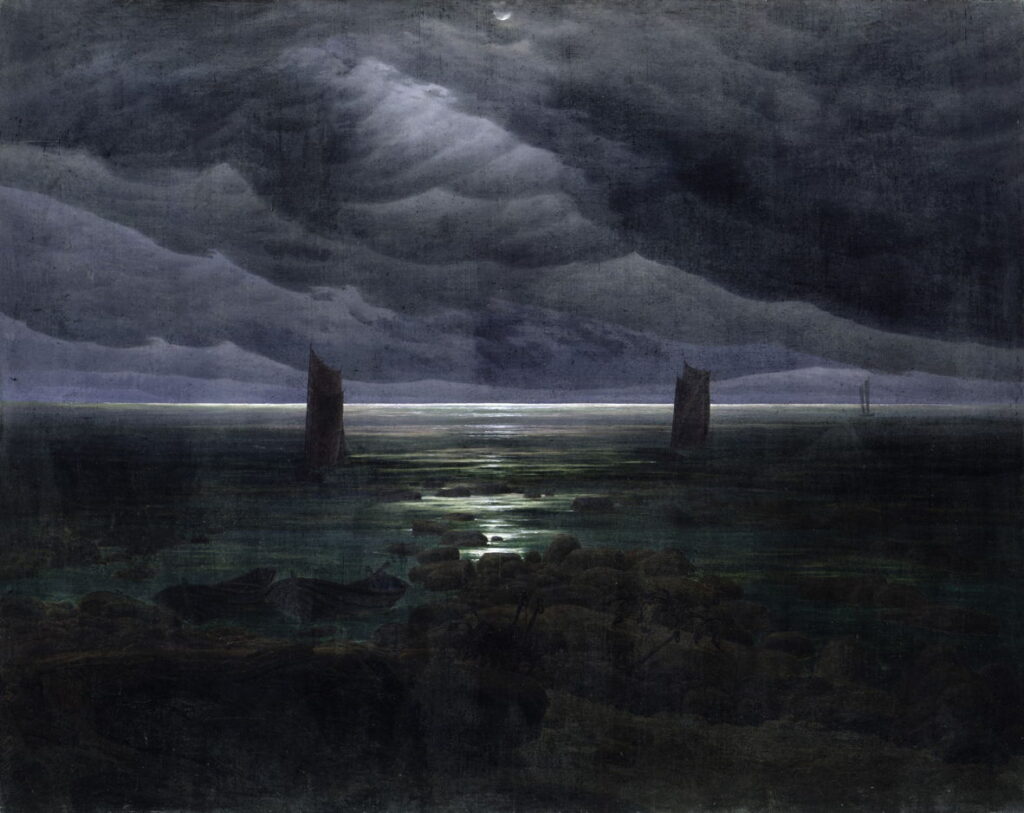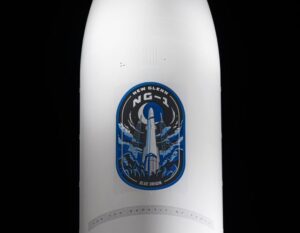Sea of Mists: Nocturnes

As I’ll show in tomorrow’s entry in the alphabet of landscapes, paintings of landscapes at night have been briefly popular but have never been a dominant theme. Yet among the German Romantic artists, nocturnes were common.
Claude-Joseph Vernet (1714–1789), The Four Times of Day: Night (1757), oil on silvered copper, 29.5 x 43.5 cm, Art Gallery of South Australia, Adelaide, Australia. Wikimedia Commons.
This probably stems from Caspar David Friedrich’s love of the pioneering landscapes of Claude-Joseph Vernet. In Night, one of his Four Times of Day from 1757, Vernet anticipates many of the features to come in the nocturnes of Friedrich and the Romantics, even down to the fully-rigged ship heading into the shore.
Caspar David Friedrich (1774–1840), Greifswald in Moonlight (1817), oil on canvas, 22.5 × 30.5 cm, Nasjonalgalleriet, Oslo, Norway. Wikimedia Commons.
Friedrich’s earlier coastal nocturnes are meticulously detailed views such as this of Greifswald in Moonlight (1817), showing his home town.
Carl Gustav Carus (1789–1869), Stone Age Stronghold at Nobbin, Rugen Island (c 1820), oil on canvas, 33.5 x 43 cm, Nasjonalgalleriet, Oslo, Norway. Wikimedia Commons.
Carl Gustav Carus started with this moonlit view of the Stone Age Stronghold at Nobbin, Rügen Island in about 1820. Here he uses the muted and faintly sinister light of the moon to enhance the drama of this ancient stone circle, on the island where Friedrich had spent his honeymoon just two years earlier.
Johan Christian Dahl (1788–1857), The Gulf of Naples. Moonlight (1820-21), oil on canvas, 35.8 x 51.9 cm, Statens Museum for Kunst (Den Kongelige Malerisamling), Copenhagen, Denmark. Wikimedia Commons.
JC Dahl’s The Gulf of Naples. Moonlight (1820-21) may have been painted at the opposite end of Europe, but it still features fishing boats and nets in the bright moonlight.
Johan Christian Dahl (1788–1857), The Bay of Naples by Moonlight (1821), oil on canvas, 49.7 × 68 cm, Thorvaldsens Museum, Copenhagen, Denmark. Wikimedia Commons.
In The Bay of Naples by Moonlight, painted the following year, Dahl used the warm glow from a modest eruption of Vesuvius to provide colour contrast, and enhance fine details of fishing nets in the foreground.
Caspar David Friedrich (1774-1840), Moonrise by the Sea (1822), oil on canvas, 55 × 71 cm, Alte Nationalgalerie, Berlin. Wikimedia Commons.
A year later, Friedrich’s Moonrise by the Sea (1822) returns to this world of darkness and shadow, showing the view from a boulder-strewn beach, looking out to sea as the moon rises from behind a bank of cloud. Two fully-rigged sailing ships from Vernet’s nocturnes head straight towards the beach.
Carl Gustav Carus (1789–1869), Seashore in Moonlight (1823), oil on canvas, 25 cm x 21 cm, Landesmuseum für Kunst und Kulturgeschichte, Oldenburg, Germany. Wikimedia Commons.
Carus’ Seashore in Moonlight (1823) looks straight at the moon, this time with just the upturned hull of a small boat on its rocks.
Caspar David Friedrich (1774–1840), The North Sea in Moonlight (1823-24), oil on canvas, 22 x 30.5 cm, Národní galerie v Praze, Prague, The Czech Republic. Wikimedia Commons.
Friedrich’s North Sea in Moonlight from 1823-24 continues the depopulation, and gathering darkness and gloom.
Caspar David Friedrich (1774-1840), Man and Woman Contemplating the Moon (c 1827), oil on canvas, 34 × 44 cm, Alte Nationalgalerie, Berlin. Wikimedia Commons.
Man and Woman Contemplating the Moon from about 1827 is an example of one of Friedrich’s recurrent motifs, of a couple in historical dress staring at the moon. A barren and twisted tree adds a sinister touch.
Carl Gustav Carus (1789–1869), Italian Moonlight (Rome, Saint Peter’s in Moonlight) (1833), oil on canvas, 28.3 x 21.5 cm, Freies Deutsches Hochstift, Frankfurt, Germany. Wikimedia Commons.
When Carl Gustav Carus was back in Italy in 1833, he painted this moonlit view of the dome of Saint Peter’s, in his Italian Moonlight (Rome, Saint Peter’s in Moonlight).
Caspar David Friedrich (1774–1840), Seashore by Moonlight (1835–36), oil on canvas, 134 × 169.2 cm, Kunsthalle, Hamburg. Wikimedia Commons.
Friedrich’s Seashore by Moonlight from 1835–36 is darker and full of foreboding, but reintroduces boats and fishing gear below the impending folds of cloud.
Johan Christian Dahl (1788–1857), Larvik by Moonlight (1839), oil on canvas, 99 × 156 cm, Nasjonalgalleriet, Oslo, Norway. Wikimedia Commons.
Shortly before Friedrich’s death in 1840, JC Dahl started a fashion for nocturnes featuring Scandinavian ports: this is his Larvik by Moonlight from 1839, following in Claude-Joseph Vernet’s tradition.
Johan Christian Dahl (1788–1857), Dresden at Night (1845), oil on cardboard, 7 × 11.3 cm, Private collection. Wikimedia Commons.
Although there’s no evidence that Friedrich made oil sketches in front of these motifs in the dark, this remarkable painting by JC Dahl of Dresden at Night appears to have been painted on a sheet of cardboard one night in 1845. At a time when portable lighting was so limited, this stands as an amazing achievement.



